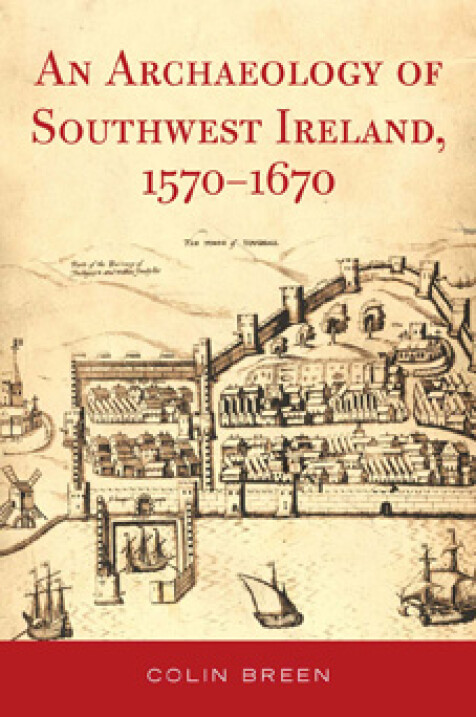An archaeology of southwest Ireland, 1570–1670
Colin Breen
‘It provides a concise summary if the history of this embattled region and offers a fine introduction to the archaeology and architecture of the period’, Matthew Stout, Studia Hibernica (October 2008).
‘A very important monograph concerning the archaeology of Ireland … [Breen] brings more than archaeology to the table; he is a competent historian, geographer, and sociologist, and weaves all of these disciplines together to create a rich narrative that tries to explain just what happened when the Gaelic orders collapsed and the New English established plantations in Munster ... Breen’s fresh approach to landscape archaeology makes for lively reading and intriguing questions … He has established himself as one of the fresh new voices in Irish history and archaeology, and we should all look forward to his further contributions ... [W]e all owe a great deal of thanks to Four Courts Press for another fine monograph production. They continue to be the leader in Irish academic publication, and this particular monograph shows why’, Thomas Finan, Australasian Journal of Irish Studies (2007/8).
‘Breen, lecturer in maritime and historical archaeology at the University of Ulster, Coleraine, has undertaken a daunting task. He explores the changes that beset southwest Ireland, mainly Munster, in a century of incredible upheaval … His study is fulsomely detailed and will profit specialists in the field and devotees of local history. An important listing and description of Munster excavations from 1975 to 2002 conclude the book. Recommended', Choice (May 2008).
‘This volume provides a long overdue and very welcome overview of the archaeology and history of Munster during a 100-year-long period which arguably witnessed the transition of Ireland from medieval to post-medievals …The volume is well illustrated with a range of historical maps and engravings, photographs, and archaeological plans … should be essential reading for anyone interested in the compelling, if convoluted, history and archaeology of late-medieval and early-post-medieval Ireland', Audrey Horning, Medieval Archaeology (Nov 2008).
‘A pioneering study that attempts to reconstruct life on the Munster Plantation … this well-illustrated book is a fascinating account of English settlement in Ireland’, Andrew Hadfield, Renaissance Studies (November 2010).
‘Colin Breen demonstrates how ... historically attested developments can be traced on the ground in Munster by the survival of field boundaries, iron and charcoal works, ports, harbours and contemporary urban centres. In addition to the documentary sources and the upstanding physical remains, Breen uses cartographic sources and the results of excavations (many of which are unpublished) to reconstruct a picture of the south-west of Ireland in the period from 1570 to 1670. The book moves on from a discussion of the historical background to chapters on urban settlement, ports and shipping, rural settlement, defence and fortification, and economy and industry (including farming and fishing)’, Michael Potterton, Landscape History (2008/2009).
'Archaeologists and amateurs will be indebted to Colin Breen’s up-to-date study of the immediate post-medieval period, which can serve as a ready handbook, providing descriptions and initial analysis of standing structures and archaeological sites. Students and scholars will also benefit from an appended list of relevant excavations in Munster, and from an excellent bibliography … There is much that is praiseworthy about this book Colin Breen’s work has immediate and lasting value, and aims at more than local consumption. One hopes the publication of An archaeology of southwest Ireland, 1570–1670 will encourage others to write additional regional archaeologies of what may prove, after all, to be the formative period of the modern Irish people', Eric Klingelhofer, Irish Historical Studies (May 2009).
‘[This book] arrives with impeccable timing and impeachable editing. Breen, a lecturer in maritime and historical archaeology at the University of Ulster, Coleraine, builds on his expertise and dissertation on the late-medieval and early modern coastal archaeology of south-western Ireland, so as to provide site-by-site analyses of both the landscape and material remains of the lordship of the O’Sullivan Beare, in Bantry and Beara in southwest County Cork (in [his previous book on] Gaelic lordship), as well as a larger overview (in An archaeology) of late medieval and early modern settlement and monument types throughout southwest Munster (essentially, west of and including Waterford and south of the Shannon). His method is historical archaeology, an exciting and fast-growing field in Ireland (witness the recent creation of both the Irish Post-Medieval Archaeology Group and the Society for Irish Historical Settlement). Some analysis is usefully cross-referenced from book to book and so they function well in tandem. … Breen’s archaeological overview opens valuable new routes for future exploration and puts a range of monuments on display, some new, some already analyzed but all freshly synthesized in a successful attempt at rescuing the national and international relevance of late-medieval and early modern Southwest Ireland', Thomas Herron, Eolas (2009).

